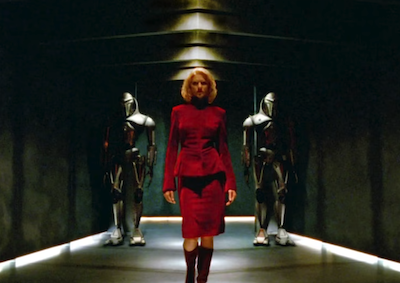Admission is free. No advance reservations. Your seat will be assigned to you when you pick up your ticket at the box office. Seats are assigned on a first come, first served basis. The box office opens one hour before the event.
A selection from the Hearst Metrotone News Collections of early conceptions of automation and “robots” in the home, office and night club will play interspersed throughout the program.
Latencies of the Statistical Image
Catalunya, 2024
The essay explores the genealogies that link today’s computer vision and artificial intelligence imaging systems to 19th-century scientific research's use of photography. Using the work of Étienne-Jules Marey and Francis Galton as case studies, the essay encourages an analysis of the latencies or cultural mutations manifest in the operative images of both periods.—Roc Albalat
DCP, color, 9 min. Director: Roc Albalat.
The Twilight Zone: “From Agnes — With Love”
U.S., 2/14/1964
A simple task for a computer engineer becomes an all-encompassing problem when emotions get involved in this tale of man vs. technology.—Programming Coordinator Nicole Ucedo
DCP, b&w, 25 min. CBS/Cayuga. Producers: William Froug, Rod Serling. Director: Richard Donner. Writer: Bernard C. Schoenfeld. With: Wally Cox, Ralph Taeger, Sue Randall.
Fembot in a Red Dress
U.S., 2015
Fembot in a Red Dress analyzes the cultural trope of the “lady in red” as it evolved from the genre of film noir to science fiction and from the human to the artificial female in a variety of film and television texts. Through juxtaposed sequences of fembots, “ladies in red,” and a combination of the two, the work attempts to mine the potential of the “critical supercut” not only for laying bare gendered patterns of representation, but also for uncovering subtle variations in meaning across cinematic texts and contexts.—Allison de Fren
DCP, color, 13 min. Director: Allison de Fren.
Not Exactly a Still Life
Switzerland, 2024
Alfred Hitchcock’s Vertigo is a film about the drive to repeat and reproduce lost things, and the failure to do so. What would it mean to repeat the images of this repetitious film with the help of AI — but as disturbing (failed) dreams rather than an exact replica? We begin to imagine a new film within the one we know. AI gives us back the history of cinema — as an uncanny double.—Johannes Binotto
DCP, color, 4 min. Director: Johannes Binotto.
Toute la data du monde
Switzerland, 2025
An experimental short essay film that reimagines Alain Resnais’ iconic 1956 essay film Toute la mémoire du monde (1956) for the AI age. Resnais’ film, on the surface a documentary portrait of the National Library of France, has commonly been understood as a meditation on the crisis of memory, knowledge and ethics after the horrors of World War II. Toute la data du monde takes some of Resnais’ images and questions as inspiration and applies them to this new current crisis of memory, knowledge and archivization in the age of AI. Through surreal, meditative and entirely AI-generated images, it suggests what the libraries of artificial intelligence and data might look like.—Evelyn Kreutzer
DCP, b&w, in French with English subtitles, 4 min. Director: Evelyn Kreutzer.
Afterlives (excerpt)
Germany/Belgium/France, 2025
Afterlives is a desktop documentary that critically engages with the historical and digital traces of extremist propaganda, questioning how images of violence circulate, mutate and persist. This excerpt explores how online platforms, including generative AI models, facilitate the disappearance and reappearance of extremist media.—Kevin B. Lee
DCP, color, 7 min. Director: Kevin B. Lee.






 Mobile Navigation
Mobile Navigation

